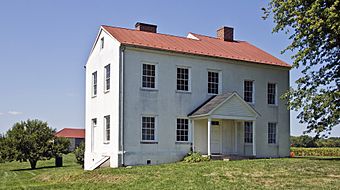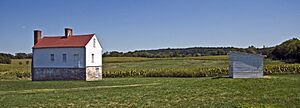L'Hermitage Slave Village Archeological Site facts for kids
Quick facts for kids |
|
|
L'Hermitage Slave Village Archeological Site
|
|

L'Hermitage Plantation-Best Farm main house
|
|
| Location | 4801 Urbana Pike, Frederick, Maryland |
|---|---|
| Area | 1.4 acres (0.57 ha) |
| NRHP reference No. | 07001450 |
| Added to NRHP | January 29, 2008 |
The L'Hermitage Slave Village Archeological Site is an archaeological site located near Frederick in Frederick County, Maryland. An archaeological site is a place where people find old objects and buildings from the past. This site is part of the Monocacy National Battlefield. It was once the L'Hermitage Plantation, started around 1793 by the Vincendière family.
The Vincendières were likely landowners from Haiti who left during the Haitian Revolution. They moved to Maryland, which was a Catholic-friendly state. L'Hermitage was known for its large size and the many enslaved people who lived and worked there. It was also known for its very strict rules and harsh conditions.
In 2010, the National Park Service explored this site. They focused on finding the old buildings, which were believed to be cabins where enslaved people lived. The Park Service bought this land in 1993. They did some early research in 2003. Today, this area is known as the Best Farm, and some of its original buildings are still standing.
Contents
Discovering L'Hermitage Slave Village Site
The L'Hermitage site helps us learn about the past. It shows us how people lived and worked on a large plantation. Archaeologists study the remains of buildings and objects found here. This helps them understand daily life for both the plantation owners and the enslaved people.
The Story of L'Hermitage Plantation
The Vincendière family arrived in Maryland around 1793. Marguerite Mangan de la Vincendière came with some of her children and a relative. Her husband stayed in South Carolina. Twelve enslaved people came with the family.
Marguerite and Etienne's daughter, Victoire, was 17 in 1793. She helped gather the land for the plantation. By 1800, she was in charge of the family. At its largest, the plantation covered about 748 acres. By 1800, there were ninety enslaved people living there.
L'Hermitage was very different from other farms nearby. Most farms in the area were smaller. They usually had fewer than a dozen enslaved people. These farms were often owned by German immigrant farmers. L'Hermitage had the second-largest enslaved population in Frederick County. It was one of the biggest in all of Maryland. The Vincendières might have wanted to create a system like the one they knew in Haiti. This system used many enslaved people to grow crops that needed a lot of work. The Vincendières built many of the buildings still seen at the site today.
Life for Enslaved People at L'Hermitage
L'Hermitage was known for its very difficult conditions for enslaved people. In 1798, a traveler named Julian Ursyn Niemcewicz visited the area. He heard stories about the unfair treatment at the plantation.
Records show nine court cases against family members for mistreating enslaved people. For example, there were cases against Boisneuf for treating six enslaved people unfairly. Victoire Vincendière also faced charges for mistreating her enslaved person named Jenny. While some charges were dropped, Boisneuf was found responsible in 1797 for mistreating an enslaved person named Shadrack. He was also found guilty of not providing enough clothes or food for his enslaved people.
The End of Slavery in Maryland
The Vincendières sold L'Hermitage in 1827. Before selling, they slowly moved most of their enslaved people to other places. Victoire moved to a house in Frederick. She passed away in 1854. At that time, she still owned three enslaved people. Her will stated that they should be set free.
Slavery continued at the property under new owners. John Brien bought the farm and continued the practice. David Best, who rented the farm from 1843, also kept enslaved people. In 1860, Best had six enslaved people. This made him one of the largest slave owners in the county. Slavery officially ended in Maryland in 1864.
The L'Hermitage site was added to the National Register of Historic Places in 2007. This means it is an important historical place that should be protected.
- L'Hermitage, Frederick County, at Maryland Historical Trust website




